Application of Basic Lymphatic Massage Sequences
Basic lymphatic treatment sequences should only be performed in the following order where the lymphatic system is intact, e.g. not interrupted by scars, radiation fibrosis, after surgery, etc.
Key massage words:
- effleurage
noun
a form of massage involving a circular stroking movement made with the palm of the hand.
verb
massage with a circular stroking movement.
Neck (supine)
1. Effleurage, 2-3 times from the sternum to the acromion.
2. Stationary circles with the fingers laying flatly in the supraclavicular fossa.
3. Treatment of the cervical lymph nodes. Stationary circles from the ear lobe to the supraclavicular fossa.
4. Stationary circles with fingers in front of and behind the ear (pre-and retroauricular LN), then more stationary circles in the direction of the supraclavicular fossa.
5. Stationary circles with fingers from the occipital region (occipital N) to the cervical lymph nodes, then more stationary circles in direction of the supraclavicular fossa.
6. Stationary circles in the area of the shoulder collectors. Four positions: 1) Acromion 2) Fingers covering the descending part of the trapezius muscle 3 Back to acromion 4) Supraclavicular fossa. All sets are done with flatly lying fingers towards the supraclavicular fossa.
7. Follow-up moves according to findings.
8. Final effleurage.
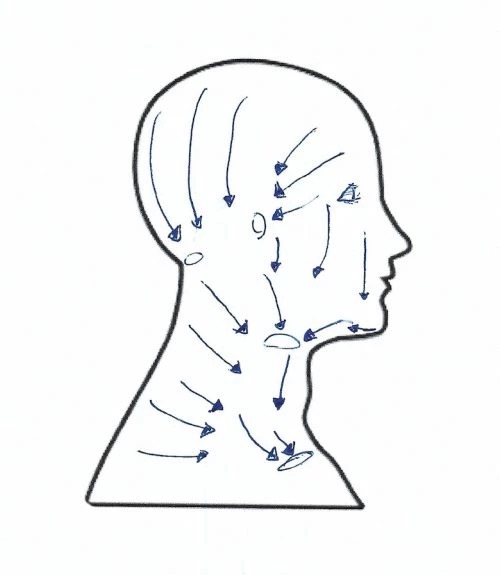
Posterior Neck (prone)
Pre-treatment: Neck supine
1. Effleurage, starting at the back of the head and working over the trapezius muscle to the
acromion process.
2. Stationary circles starting at the angle of the jaw and working in the direction of the supraclavicular fossa.
3. Stationary circles in several tracks on the back of the head, working in the direction of the occipital and retro-auricular lymph nodes, then again in the direction of the supraclavicular fossa.
4. Stationary circles paravertebrally with erected fingers, working deep.
5. Follow-up moves according to findings.
6. Final effleurage.
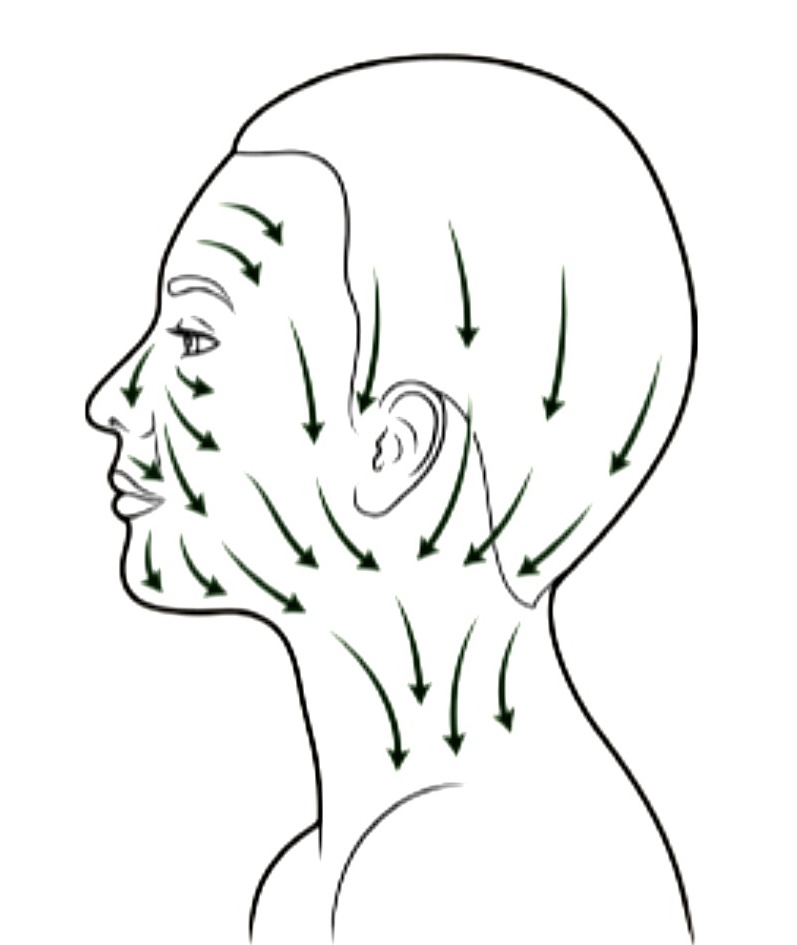
Face
Pre-treatment: Neck, if indicated posterior neck.
1. Effleurage along the lower jaw, the upper jaw, the cheek and the forehead, in the direction of the angle of the jaw.
2. Stationary circles with erected fingers in the the submental and submandibular regions, working from the tip of the chin in the direction of the angle of the jaw, then in the direction of the supraclavicular fossa.
3. Stationary circles starting at the lower jaw and working towards the submental and submandibular lymph nodes (angle of the jaw) and then to the supraclavicular fossa.
4. Stationary circles starting at the upper jaw and working towards the submandibular lymph nodes, then to the angle of the jaw, and again to the supraclavicular fossa.
5. Stationary circles with the finger tips starting at the tip of the nose and moving towards the cheeks in several passes, each pass beginning one finger-width more superior until reaching the bridge of the nose.
6. Stationary circles starting on the cheek below the eye in several sets in the direction of the submandibular lymph nodes, to the angle of the jaw, and again to the supraclavicular fossa.
7. If indicated, working at the upper and lower lid and the eyebrows with stationary circles (one or more fingers) in the direction of the preauricular lymph nodes.
8. Stationary circles starting at the middle of the forehead to the temple, then towards the angle of the jaw.
9. Follow-up moves according to findings.
10. Final effleurage.
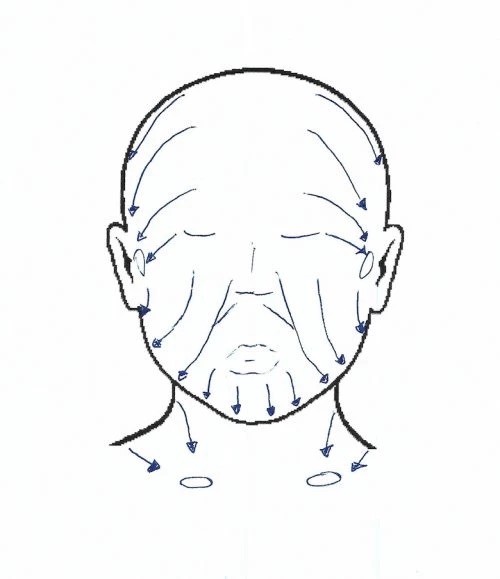

Anterior Thorax (Chest) and Breast
Pre-treatment: “Short” neck.
1. Effleurage in several paths starting at the sagittal watershed and working towards the axillary lymph nodes.
2. Stationary circles on the axillary lymph nodes.
3. Alternating stationary circles on the lateral trunk, starting at the horizontal watershed and working towards the axillary lymph nodes.
4. Treatment of the breast: The lower hand starts with the pump, diagonally with three strokes in the direction of the axillary lymph nodes: 1st stroke below the breast, 2nd at the gland tissue, and 3rd below the nipple. The upper hand does stationary circles or rotary techniques from the sagittal watershed towards the axillary lymph nodes. Both hands alternate.
5. Alternating rotary strokes starting at the sagittal watershed (lower hand parallel to the transverse watershed) and working towards the lateral trunk, then with alternating stationary circles in the direction of the axillary lymph nodes.
6. Stationary circles from the sagittal watershed (sternum) towards the axillary lymph nodes.
7. If indicated, stationary circles with slightly spread fingers in the intercostal spaces from lateral to medial; wave-like movements with pressure working deep.
8. If indicated, stationary circles with fingers in the intercostal spaces along the sternum (parasternal lymph nodes), pressure working deep.
9. Follow-up moves according to findings.
10. Change to the other side and repeat Steps 1-9.
11. Final effleurage.
Posterior Thorax (Back)
Note: Superficial lymph vessels of the posterior thorax drain into the axillary lymph nodes. Lymph vessels of the inner wall of the thorax (intercostals collectors) connect to the paravertebral lymph nodes.
Pre-treatment: “Short” neck, axillary lymph nodes.
1. Effleurage in several paths starting at the spinal column and working in the direction of the axillary lymph nodes.
2. Stationary circles alternating on the lateral trunk starting at the transverse watershed and moving to the axilla.
3. Rotary techniques in several passes from the spinal column towards the axilla/lateral trunk. Working between spine of the scapula and transverse water sheds.
4. Alternating rotaries starting at the spinal column with lower hand along the transverse watershed, working towards lateral, then with alternating stationary circles in the direction of the axillary lymph nodes.
5. Stationary circles starting at the spinal column (scapula) and working towards the axillary lymph nodes.
6. If indicated, stationary circles with slightly spread fingers in the intercostal spaces from lateral to medial: wave-like movements with pressure working deep.
7. If indicated, stationary circles with erected fingers paravertebral, working deep.
8. Follow-up moves according to findings.
9. Change to the other side and repeat Steps 1-8.
10. Final effleurage.
Upper Extremity (UE)
Pre-treatment: “Short” neck.
1. Effleurage: soft strokes over the entire UE.
2. Stationary circles on the axillary lymph nodes in two to three sets; the head-hand is
working, the other hand holds the arm in proper position.
3. Stationary circles on the medial aspect of the upper arm in several sets, beginning at the medial epicondyle and moving in the direction of the axilla.
4. Stationary circles alternating on the anterior and posterior portion of the deltoid muscle, with pressure going towards the axillary lymph nodes.
5. Pump technique on the lateral aspect of the upper arm (deltoid-area) in several passes, working towards the acromion.
6. Combination of pump and stationary circle (alternating hands) on the lateral upper arm, beginning at the lateral epicondyle.
7. Stationary circles in the ante-cubital fossa as well as thumb circles in the area of the medial and lateral epicondyle.
8. Stationary circles on medial side of forearm.
9. Combination of pump and stationary circle on the forearm.
10. Thumb circles alternating or stationary circles with flat fingers/hand over the dorsal aspect of the wrist and hand.
11. Thumb circles over the palmar aspect of the wrist and palm (for the ulnar and radial
bundle), following the path of the collectors.
12. Thumb/finger circles on each individual finger.
13. Follow-up movements according to findings.
14. Final effleurage.



Lower Extremity (LE)
Pre-treatment: “Short” neck, abdomen and abdomen with deep breathing.
Anterior LE:
1. Effleurage: soft strokes covering the entire LE.
2. Stationary circles with both hands at the same time on the inguinal lymph nodes in two sets, lateral aspect first then medial aspect of the inguinal lymph nodes.
3. Stationary circles alternating at the medial thigh, beginning at the medial aspect of the knee.
4. Pump techniques alternating at the anterior thigh in several sets, beginning at the patella.
5. Combination of pump and stationary circle in passes, at the anterior then the lateral thigh, with passes beginning at the knee.
6. Knee:
- a. Pump with one hand in several sets over the anterior knee.
- b. Stationary circles at the same time medial and lateral at the knee, dynamically.
- c. Stationary circles in the popliteal fossa with both hands.
- d. Stationary circles at the same time below the medial aspect of the knee (proximal calf).
7. Alternating pump or pump and stationary circles on anterior lower leg.
8. Stationary circles at the same time behind the malleoli.
9. Stationary circles with thumbs alternating or flat fingers/hand over the ankle, dorsum of the foot, and toes.
10. Follow-up moves according to findings.
11. Final effleurage.
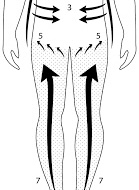
Posterior LE treatment:
1. Effleurage: soft strokes covering the entire leg.
2. Pump strokes alternating at the posterior leg, beginning at the popliteal fossa.
3. Stationary circles alternating at the medial thigh.
4. Combination of pump and stationary circle on the posterior and lateral thigh in several sets.
5. Knee: stationary circles at the popliteal fossa.
6. Alternating pump strokes in several sets along the calf, beginning at the Achilles tendon.
7. Combination of pump and stationary circle over the calf in several sets.
8. Thumb circles at the same time along the Achilles tendon in several sets.
9. Follow-up moves according to findings.
10. Final effleurage
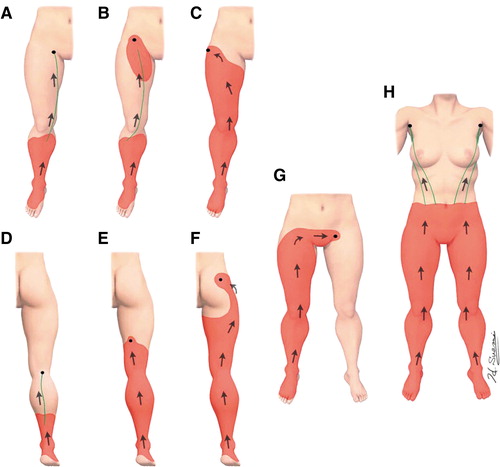
Lumbar and Gluteal Region
Pre-treatment: “Short” neck, abdomen, abdomen with deep breathing, inguinal lymph nodes.
1. Effleurage: sacral and gluteal areas, working in the direction of the inguinal lymph nodes.
2. Alternating rotary techniques from the sagittal watershed towards lateral (inguinal LN)
3. Stationary circles from the sagittal watershed towards the inguinal lymph nodes.
4. Stationary circles hand-over-hand between the thoracic cage and the iliac crest; wave-like movements with pressure towards the lumbar trunk/cisterna chyli. The pressure is exerted with the upper hand; the lower hand is passive.
5. If indicated, stationary circles paravertebral with erected fingers working deep.
6. Follow-up movements according to findings.
7. Final effleurage.


Abdominal and “Deep” Abdominal Treatments
Contraindications: All general MILD contraindications plus pregnancy, menstruation, ulcerative colitis, diverticulitis, history of deep pelvic vein thrombosis, abdominal aortic aneurysm (AAA), Cohn’s disease, radiation colitis, radiation cystitis, any other inflammatory conditions in the abdominal cavity, undetermined pain, and others.
Note: A rebound (quadrant) test should precede the first abdominal treatment; the client should be positioned with flexed knees and elevated upper body. Apply firm pressure with flat fingertips into each quadrant of the abdomen. If pain is noted upon sudden release, avoid abdominal treatment until the client has been seen by physician. In this case, the therapist may apply MLD to other areas of the body and replace the abdominal treatment with deep breathing.
Patient should be positioned with elevated legs (with a knee roll or wedge) and elevated upper body (with a pillow). Therapist usually stands on the right side of the patient.
1. Effleurage: soft strokes from the pubic bone towards the sternum, then along the rim of the thoracic cage and the iliac crest back to the pubic bone, then following the ascending, transverse and descending parts of the colon.
2. “Deep” stationary circles along the descending, ascending and transverse colon in several sets, with pressure directed towards the cisterna chyli.
Abdominal Treatment Combined with Deep Breathing (a.k.a. Deep Abdominal)
With this technique, deeper situated lymphatic structures are influenced, such as the thoracic duct, cisterna chyli, lumbar trunks, pelvic and lumbar lymph nodes and the organ structures with their lymphatic systems.
The deep abdominal drainage technique is combined with deep breathing and applied at five different points in the abdominal area. Instruct the patient to perform deep diaphragmatic breathing which may require practice.
After properly positioning hands in the abdominal area, allow the abdomen to protrude during inhalation. On the exhalation, apply gentle pressure to the client’s tolerance but never deeper than the point where you can feel the aortic pulse. During the following inhalation, offer resistance until the patient is almost at the end of the inhalation. During a short pause between inhalation and exhalation, shift hands to the next position.
Repeat the cycle until all points have been treated or until the patient’s tolerance for this treatment has been reached.
Finish with effleurage.
